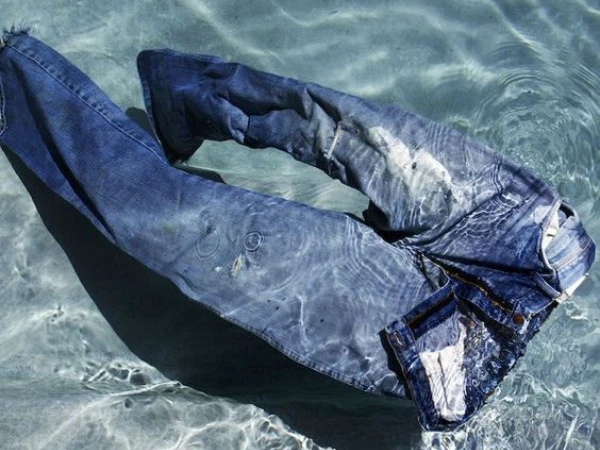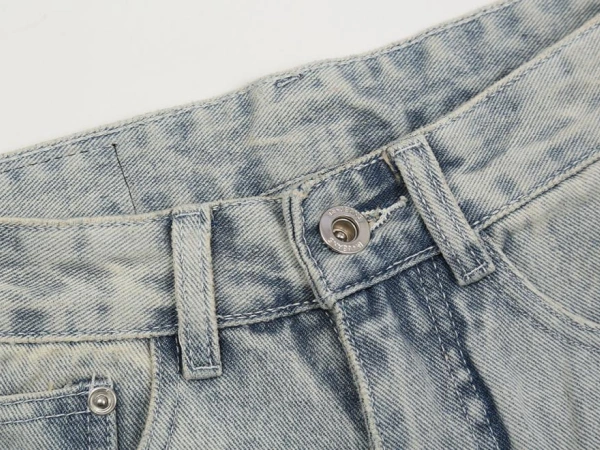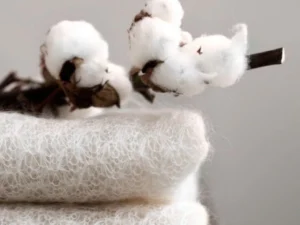مقدمة
Light-colored jeans, especially white or pastel denim, can be an elegant and versatile part of any wardrobe. However, they also present a unique set of challenges, particularly when it comes to maintaining their pristine appearance. One of the most common issues faced by denim wearers is the oxidization and yellowing of light-colored jeans. Whether it’s a result of everyday wear or improper care, this problem can make your favorite pair of jeans look old and worn out prematurely.
Understanding the Causes of Oxidization and Yellowing
Oxidization refers to the chemical reaction between the fabric and oxygen in the air, leading to the breakdown of dye molecules and the gradual fading or yellowing of the denim. This process is naturally accelerated by exposure to sunlight, air, sweat, and even pollutants in the environment.
Yellowing, on the other hand, is typically caused by a buildup of body oils, sweat, or other contaminants that come into contact with the fabric. Over time, these substances can leave behind visible stains that are difficult to remove.

- Factors Contributing to Oxidization and Yellowing in Light-Colored Jeans
Several factors contribute to the oxidation and yellowing of light-colored denim:
- Natural Aging of Denim
Denim, like any fabric, naturally ages over time. Light-colored fabrics are particularly susceptible because their fibers tend to reflect dirt and contaminants more easily. The constant exposure to environmental elements, such as air and light, contributes to the slow process of oxidation, which can eventually lead to noticeable yellowing.
- Fabric Composition
Not all denim is created equal. The composition of the fabric can influence how easily it reacts to oxidizing agents. For example, synthetic fibers like polyester may resist oxidation more than pure cotton denim, while low-quality denim with cheaper dyes can also be more prone to yellowing. Light-colored jeans made from 100% cotton are more likely to yellow because cotton absorbs moisture and oils, which can turn yellow when exposed to heat.
- Environmental Factors
Sunlight, humidity, and pollution are major contributors to the breakdown of fabric dyes. Sun exposure, in particular, can cause denim to lose its vibrancy and start to yellow. The heat and ultraviolet rays in sunlight can break down the dye molecules, leading to a dull appearance. Similarly, air pollution, especially in urban areas, can leave residues on the fabric that contribute to discoloration.
- Body Oils and Sweat
Sweat, oils, and skin residues can be absorbed by denim fibers, particularly when they are in contact with the skin for long periods. This is especially true in the waistband, crotch, and thigh areas. Body oils can leave behind yellow stains that, if not properly cleaned, can become more difficult to remove over time.
- Improper Washing and Detergents
The way you wash your jeans plays a crucial role in preventing yellowing. Using hot water, harsh detergents, or bleach can break down the fabric’s natural fibers and remove its color, leading to yellowing. Additionally, over-washing your jeans can accelerate the oxidation process. It’s important to adopt gentler washing methods to maintain the integrity of light-colored denim.
Effective Strategies to Prevent Yellowing and Oxidization
Now that we understand the causes of yellowing and oxidization, let’s dive into some effective strategies that can help prevent these issues and keep your light-colored jeans looking their best.
- Proper Storage
The way you store your jeans plays a big role in preventing oxidization and yellowing. Always store your light-colored jeans in a cool, dry place. Avoid exposing them to direct sunlight for extended periods, as this can accelerate fading and yellowing. If you’re not planning to wear your jeans for a while, consider storing them in a garment bag or a closet with proper ventilation to minimize the risk of environmental exposure.
- Washing Techniques
The first rule of washing light-colored jeans is to always follow the care label. In general, it’s best to wash them inside out in cold water to preserve both the fabric and the color. Cold water prevents the fabric from shrinking and helps protect the dye from breaking down. Wash your jeans with similar colors to avoid color transfer, and use a mild detergent that is free from harsh chemicals. Avoid using bleach as it can weaken the fabric and cause yellowing over time.

- Choosing the Right Detergent
Not all detergents are created equal. Opt for a mild detergent that is specifically formulated for delicate fabrics. These detergents are designed to clean without stripping the color or damaging the fibers. Some detergents even contain whitening agents that can help prevent yellowing by removing stains and brightening the fabric. Be sure to avoid strong chemical-based detergents or fabric softeners, which can contribute to yellowing.
- Drying Methods
Proper drying is crucial in preventing the yellowing of light-colored jeans. Always air-dry your jeans rather than using a dryer. Excessive heat from a dryer can cause the fabric to fade and weaken, leading to yellowing. If possible, hang your jeans in a shaded area to dry, as direct sunlight can also cause the fabric to yellow over time.
- Using Fabric Conditioners and Anti-Oxidation Products
There are several fabric conditioners and anti-oxidation products available on the market that can help protect light-colored denim. These products often contain ingredients that create a protective layer on the fabric, helping to prevent the absorption of sweat, oils, and environmental pollutants. Be sure to choose one that is specifically designed for light-colored fabrics to avoid any negative effects.
Practical Examples and Case Studies
- Example 1: A customer noticed their white jeans were starting to yellow around the waistband and thighs. After switching to a milder detergent and washing the jeans inside out in cold water, they noticed a significant improvement. They also started air-drying their jeans instead of using a dryer, which helped prevent further yellowing.
- Example 2: A boutique specializing in light-colored denim discovered that their stock of white jeans was starting to yellow due to improper storage. They switched to using garment bags and stored their jeans in a cool, dry closet, away from direct sunlight. This simple change helped preserve the freshness of their denim inventory.
What to Do if Your Jeans Have Already Yellowed
If your jeans have already started to yellow, don’t panic. There are several methods you can try to restore them.
Home Remedies
Common household items like vinegar, baking soda, and lemon juice can be used to treat yellowing on light-colored jeans. For example, a mixture of vinegar and water can help break down the oils and dirt that cause yellowing. Simply soak the affected areas for about 30 minutes before washing as usual.
Professional Cleaning Services
For stubborn stains or severe yellowing, you may need to take your jeans to a professional cleaning service. They have specialized equipment and products that can restore the fabric without causing further damage.
Prevention After Treatment
After treating yellowed jeans, it’s important to implement the preventive measures discussed earlier to ensure the issue doesn’t return. Regular maintenance is key to keeping your light-colored jeans looking fresh.
خاتمة
Preventing yellowing and oxidization in light-colored jeans requires attention to detail in both daily wear and care routines. By understanding the causes of yellowing and implementing proper storage, washing, and drying techniques, you can ensure that your jeans stay bright and vibrant for years to come. Small changes, such as using a mild detergent, air-drying your jeans, and avoiding harsh chemicals, can make a significant difference in preserving the appearance of your favorite light-colored denim.
Ultimately, prevention is the key to keeping your jeans in top condition, but if yellowing does occur, there are simple remedies and professional services available to restore their original look. By adopting these habits and taking care of your denim, you can enjoy clean, fresh-looking jeans for as long as possible.





